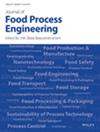Optimization of extraction of liquid extract from microalgae Chlorella vulgaris via cavitation-based techniques
Abstract
Microalgae are a high-potential source of biomolecules. Therefore, extracting bioactive components from microalgae with efficient and green extraction techniques is an important objective in many research. Cavitation-based extraction is gaining widespread attention as an environmentally friendly method due to its reduced energy and solvent consumption, enhanced extraction yield, improved extract quality, and reduced extraction time to extract bioactive products. This study aims to examine and optimize the extraction method for bioactive products from Chlorella vulgaris using Cavitation-based techniques compared with the traditional method to enhance the efficiency of extracting liquid extract. This experiment examined the extraction of bioactive components using various extraction methods, including Maceration, ultrasound-assisted extraction (UAE) (2–8 min) and hydrodynamic cavitation extraction (HCE) (1–5 min) was investigated regarding the extract's minerals, vitamins, amino acids, phytohormones, and total carbohydrates. The experimental design followed a response surface methodology to assess the effects of ultrasound-assisted and hydrodynamic cavitation extraction of liquid extract. The optimum time for maximum content of bioactive components using UAE and HCE was obtained at 7.87 and 1.76 min, respectively. This study showed that in comparing the three methods, Maceration (ME), UAE, and HCE, the UAC method was more useful and had a shorter extraction time compared with the ME and HCE methods for extracting bioactive products from C. vulgaris. Also HCE was more useful compared with the ME method. These results demonstrate that the cavitation-based extraction methods are more effective and efficient than traditional extraction methods.
Practical applications
- Extract of Microalgae Chlorella vulgaris is a high-potential source of bioactive compounds.
- Ultrasonic is one of the most effective techniques for the extraction of bioactive compounds of microalgae.
- The Hydrodynamic cavitation technology can be considered a green technology for large-scale extraction of bioactive compounds of microalgae.
- The cavitation-based extraction methods are more efficient than traditional extraction methods.
- Optimization of the extraction techniques can promote reductions in cost and time.


 求助内容:
求助内容: 应助结果提醒方式:
应助结果提醒方式:


